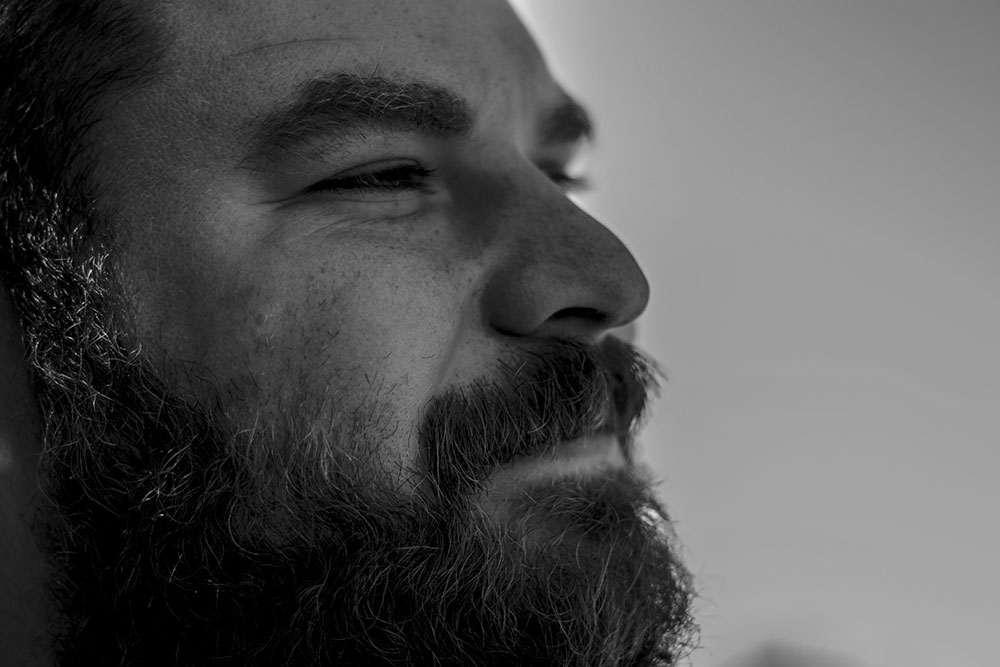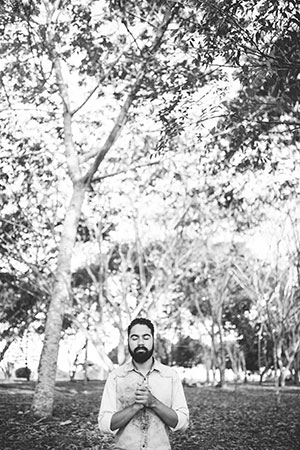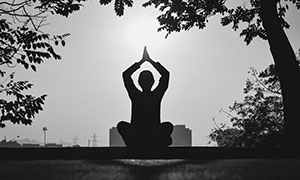News and Tools for
Happiness, Love, and Wisdom
volume 12.4 • 2018
In This Issue
Somatic Intelligence
Body-Brain Based Strategies to Strengthen Resilience and WelL- Being
© 2018 Linda Graham, MFT
Your nervous system is beautifully designed to react super-quickly to any sense of potential danger to your safety or well-being…when another car suddenly swerves into your lane on the freeway…when you shred the wrong client file at work…when you leave your laptop on a plane...
Anytime something suddenly goes haywire, you will most likely experience a sudden startle – aagh! – in your body because the most automatic responses to all of life’s hiccups and hurricanes begin in the body. Your nervous system is alerting you, in milliseconds, to “Pay attention! Something important is happening here!” And then activating you in another few seconds to “Move! Now!” to deal with the potential danger or catastrophe.
We want to be able to respond to these moments of sudden startle and “uh, oh!” quickly and wisely, skillfully, effectively. To be resilient in this way, we need to soothe the startle in our nervous system and move from reactivity (that’s automatic; hard-wired in by evolution) to receptivity and responsiveness, to take action from a mature response flexibility that is the brain’s essential capacity of our resilience. We want to cultivate practices that will quickly reliably return us to our natural baseline physiological equilibrium known as our “range of resilience.” To recover the steady calm “in here” that allows us to deal with whatever is “out there.”
Research findings in modern neuroscience and the behavioral sciences are dovetailing nicely to illuminate which practices will most reliably strengthen our somatic intelligence, using body-based tools of breath, touch, movement, and visualization to return us to our range of resilience, from which we can see clearly and act wisely.
The tools below are from Resilience: Powerful Practices for Bouncing Back from Disappointment, Difficulty, and Even Disaster. They are simple practices with big effects. You can practice them “little and often” which is precisely how the brain learns, unlearns, and relearns anything ever, small incremental experiences repeated many times. These practices of somatic intelligence with help you cope with bumps and bruises inevitable in a human life, from barely a wobble to serious sorrows and struggles to the tragedies of “too much.”

USING THE BREATH TO RESET THE NERVOUS SYSTEM
To breathe is to be alive. Every inhalation activates the sympathetic branch of your nervous system just a little bit (a lot when you overreact to something and hyperventilate). Every exhalation activates the parasympathetic branch just a little bit (a lot when you feel scared to death and faint). You can learn to use a conscious rhythm of gently breathing in and out to reliably regulate the revving up and shutting down of your nervous system, increasing your response flexibility to cope with anything, anything at all.
Deep Sigh
Let your body sigh. Give yourself permission to breathe in gently, then exhale deeply for several rounds. You can make a soft “ahhhh” sound on the exhale if you wish.
Greetings
The Wise Brain Bulletin offers skillful means from brain science and contemplative practice – to nurture your brain for the benefit of yourself and everyone you touch.
The Bulletin is offered freely, and you are welcome to share it with others. Past issues are posted at http://www.wisebrain.org/tools/wise-brain-bulletin.
Rick Hanson, PhD, edits the Bulletin. Michelle Keane is its managing editor, and it’s designed and laid out by the design team at Content Strategy Online.
To subscribe, go to http://www.wisebrain.org/tools/wise-brain-bulletin.
A deep sigh is your body-brain’s natural way to release tension and reset your nervous system. Even as what you’re coping with becomes more challenging, you can deliberately pair any moment of tension or frustration with a sigh to shift your physiology into a relieved and more relaxed state.
Additional breath practices to restore a sense of calm and safety:
Mini-Breath Meditation
1. Breathe naturally, gently, for five to ten breaths. Pay attention to the sensations of breathing in (notice the cool air in your nostrils or throat and the gentle expansion of your belly and chest) and breathing out (notice warmer air flowing out and the relaxation of your belly and chest). Remember the practical power of “little and often.” Pause and repeat this practice many times a day.
2. If you wish, you can say these phrases from the Zen master Thich Nhat Hanh silently to yourself as you breathe: “Breathing in, I am home. Breathing out, I smile.”
3. As you inhale, you can imagine “coming home” to yourself, saying, “I am here. I am home.” As you exhale, imagine connecting safely with the world outside yourself, coming into ease and harmony with others. Imagine breathing in to the word me, breathing out to the word we. Repeat this rhythm for a full minute.
Affectionate Breathing
[adapted from the mindful self-compassion protocol developed by Kristin Neff and Chris Germer]
Here you use kind awareness of your breathing to strengthen a sense of safety and calm in your body and your mind.
1. Find a comfortable position in which your body is supported and you don’t need to make an effort to remain in that position. Close your eyes if you wish, or allow your eyes to soften their gaze. Come into a sense of presence, relaxing in your body. Take a few slow, easy breaths to release any unnecessary tension.
2. Focus your awareness on your breathing, noticing where you perceive the breath most easily. Let yourself notice the simple sensations of breathing, just feeling your breath for a while.
3. See if you can orient toward yourself and your breathing with openness, curiosity, and care. If you notice any discomfort in your mind or body, see if you can simply be with that discomfort, soften toward it, accepting that this is so in this moment. Bring a sense of kindness toward yourself.
4. Notice how you don’t have to remember to breathe. Your body breathes for you. Your body is breathing you.

5. See if you can feel your whole body breathing. Notice how your breathing expands into your entire body and nourishes every cell in your body.
6. Give yourself over to the breath. Let yourself become the breath. Rest in the ease of this moment for a minute or two.
7. Perhaps allow a moment of appreciation or gratitude for the breath that sustains your life in every moment.
8. Finally, release your awareness of your breathing. Allow everything that comes to awareness to be just as it is, for now. When you’re ready, open your eyes.
This exercise can help you appreciate your own intentions and wise effort in creating or deepening a genuine sense of ease and equilibrium that supports your resilience. Know that you are learning a tool that will help you reliably regulate the revving up and shutting down of your nervous system, increasing your response flexibility, strengthening your resilience.
USING TOUCH TO RESTORE A SENSE OF SAFETY AND TRUST
Much of the power of our innate somatic intelligence to soothe the nervous system and restore a sense of safety and trust in the moment rests in the power of touch. Warm, safe touch activates the release of oxytocin, the brain’s direct and immediate antidote to the stress hormone cortisol. Touch, along with physical proximity and eye contact, activates the body-brain’s social engagement system, immediately evoking a viscerally felt sense of reassurance that “Everything is okay; you’re fine.”
Hand on the Heart
This practice is powerful enough to calm down a panic attack in less than a minute.
1. Place your hand on your heart. Breathe gently, softly, and deeply into the area of your heart. If you wish, breathe in a sense of ease or safety or goodness into your heart center.
2. Remember one moment, just one moment when you felt safe, loved, and cherished by another human being. Don’t try to recall the entire relationship, just one moment. This could be a partner, a child, a friend, a therapist, or a teacher; it could be a spiritual figure. Remembering a loving moment with a pet can work very well, too.
3. As you remember this moment of feeling safe, loved, and cherished, let yourself experience the feelings of that moment. Let the sensations of the feelings wash through your body. Let yourself stay with these feelings for twenty to thirty seconds. Notice any deepening in a visceral sense of ease and safety.
Repeat this practice many times a day at first, to strengthen the neural circuitry that remembers this pattern. Then practice this exercise whenever you experience the first signal of a startle or an upset. With practice, it will enable you to back out a difficult emotional reaction before it hijacks you. Then you can repeat hand on the heart any time you need to, any time at all. It’s portable equilibrium.
Additional practices of touch to restore a sense of safety and ease.
Hugs
Exchange a twenty-second hug with a person or pet you feel safe with. Twenty seconds (about three breaths) is enough to release the oxytocin in both hug-ees,  a self-reinforcing loop of bonding and belonging for each person.
a self-reinforcing loop of bonding and belonging for each person.
Energize Your Heart Center
Neural cells are part of the structure of your heart. Warm, safe touch activates those neurons; your body feels the implicit comforting energy of your brain’s social engagement system.
1. Ask someone you feel safe with to sit beside you.
2. Place your hand on your heart. As you do so, ask the other person to gently place their hand on the middle of your back, on a level with your hand on the front of your body. (You can also experience the energy shift of this exercise by remembering the feeling of connection with another as you lean your back into a cushion while sitting on a firm couch or chair.)
3. Breathe gently in and out. Feel the sense of stable energy in the center of your torso. Relax into the ease and comfort of an active, non-verbal social engagement system.
USING MOVEMENT TO SHIFT OUR PHYSIOLOGY…AND OUR MOOD
Any time you move your body and shift your posture you shift your physiology. Any time you shift your physiology you shift the activity of your autonomic nervous system and its state of excitement-calm-shut down. You can use movement to shift your emotions and your mood.
Frowning and Smiling
You can experience the sequence of this shift when you first place and hold a pencil between your nose and your upper lip (which requires you to somewhat frown) and then place the pencil between your teeth (which requires you to somewhat smile.) You can notice the felt sense of the forced frown; you can notice the felt sense of the forced smile; you can notice the shift between the two, and with practice, you can notice the shift in your inner state from this shift in your physiology.
Tensing and Relaxing
Bring your awareness to your hands, and slowly tense your hands into fists, and then release the tension into your open palms. Do that tensing-releasing a couple of times. Notice any shifting of your inner state.
Movement Opposite
You can apply this practice of shifting your posture to shift any agitation or collapse of your nervous system, any state of fear, anger, sadness, disgust.
1. Identify one specific emotion or physical state you would like to explore and shift through movement of the body.

1. Stand up in a place where you have space to move. Settle into a posture of feeling comfortable and at ease in your body.
2. Let your body move into a posture that expresses or embodies that emotional state you want to work with. Let your body assume or inhabit this first “negative” posture for 30-40 seconds. Let yourself feel the felt sense of this physiological state without being too caught in it or overwhelmed by it.
3. Let your body move on its own, without thinking at all, without going to your head at all, to the opposite posture. You don’t even have to know what this second opposite posture is called, it simply feels “opposite.” Inhabit this second opposite posture for 30-40 seconds.
4. Let your body return to the original negative posture for 20 seconds, the return to the opposite positive posture for 20 seconds, then let your body feels its way into a posture that feels something in the middle. Remain in this middle integrative posture for 30 seconds.
5. Take a moment to reflect on the entire experience, noticing any shifts or insights from doing the exercise.
The first time I used this technique with a client, he was exploring depression. He had assumed the posture opposite to depression would be one of happiness. To his surprise and to his learning, he realized the opposite of depression for him in that moment was reverence. He had shifted his experience; he had learned from the intuitive wisdom of his own experience.
USING VISUALIZATION TO CREATE LASTING RESOURCES
Fully 25 percent of your brain’s real estate is devoted to visual processing in the occipital lobe. Researchers now know that when we imagine seeing a banana, the same neurons light up in the visual cortex as when we see a banana in real life. This means that imagined scenarios can be as real to the brain as actual observations. You can use this power of visualization and imagination to create the inner resource of a safe place – a safe base to come home to - or a resource of a soothing or inspiring landscape, even inner relational resources such as a wiser self or wise guide that support your inner resilience.
1. Meeting Your Compassionate Friend
[adapted from the mindful self-compassion protocol developed by Kristin Neff and Chris Germer]

This guided visualization creates a feeling of being listened to, heard, and cared about, which can become a body-based resource for the mind and heart. Whatever upset or distress we are experiencing, we can also experience the tenderness of care.
1. Allow yourself to sit or lie down comfortably, coming into a sense of presence — being aware of being in your own body, in this moment, focusing your awareness on the gentle rhythm of your breathing, coming into a sense of relaxation and peacefulness. Then, when you’re ready, imagine that you are in your own safe place, a comfortable place where you can feel protected, at ease, and content. This may be a room in your own home, a favorite bench in a park or on a hill overlooking the beach, or in a café with a friend. Let yourself settle into the security and comfort of being in your safe place.
The Wellspring Institute For Neuroscience and Contemplative Wisdom
The Institute is a 501c3 non-profit corporation, and it publishes the Wise Brain Bulletin. The Wellspring Institute gathers, organizes, and freely offers information and methods – supported by brain science and the contemplative disciplines – for greater happiness, love, effectiveness, and wisdom. For more information about the Institute, please go to http://www.wisebrain.org/wellspring-institute.
If you enjoy receiving the Wise Brain Bulletin, please consider making a tax-deductible donation to the Wellspring Institute. Simply visit WiseBrain.org and click on the Donate button. We thank you.
2. Then, let yourself know that you are going to receive a visitor, someone older, wiser, and stronger, someone who knows you well and cares about you a great deal. This figure may be someone you already know; it may be someone completely imaginary. It could be simply a sense of warm, loving presence. However this works for you, this figure wants you to be happy, and they want to visit with you for a little while.
3. As you imagine this compassionate friend coming to visit you in your safe place, imagine in detail what they look like, how they’re dressed, and how they move. Imagine what it feels like for you to be in their presence, in their energy field.
4. Imagine how you meet and greet this figure: do you stand up and shake hands, do you hug, do you bow?
5. Then imagine how you will have a conversation with this compassionate friend: sitting face to face, sitting side by side, going for a walk.
6. Begin to share with this compassionate friend some current worry, some upset, or some distress. Imagine what it feels like to share this concern with your compassionate friend. Does your energy shift or change in any way as you begin to share it?
7. Imagine your friend listening receptively, openly, understandingly. Imagine how you feel being listened to and understood and accepted by this compassionate friend.
8. Imagine any words of acceptance or encouragement or support your compassionate friend might have to offer. If you could hear whatever you need to hear right now, what would those words be? As you imagine listening, sense what you feel as you hear these words.
9. When the conversation is complete and it’s time for your friend to depart, imagine how you say good-bye, knowing that you can visit with this compassionate friend again any time you wish to.
10. When you are in your safe place by yourself again, take a moment to pause, notice, and reflect on your experience. Reflect on any shifts in your experience of yourself or the upset you were working with, knowing that you have tapped into your own deep, intuitive wisdom.
As you evoke your compassionate friend, you are activating your own oxytocin-based caregiving system, which calms your nervous system and restores your physiological and emotional equilibrium. As evoking your compassionate friend becomes a reliable habit in your brain, you can deepen your sense that you are not alone in your struggles, which can be very nurturing to your resilience.

All of these practices will help you cultivate more calm in the body, restore the natural physiological equilibrium - the “range of resilience” - of the body-brain, and access a deeper sense of safety and well-being that primes your brain for more resilient learning and coping.
Additional practices to strengthen your emotional, relational, and reflective intelligence as well as somatic intelligence are available in Resilience. Simple tools with big effects. Not only will you learn practices that will help you cope with any upset or catastrophe and bounce back from any adversity that would derail your well-being. You will learn to see yourself as someone who can learn, who can cope.
I am no longer afraid of storms, for I am learning how to sail my ship.
- Louisa May Alcott
ABOUT THE AUTHOR

Linda Graham, MFT is an experienced psychotherapist and mindful self-compassion teacher in the San Francisco Bay Area. She is the author of Resilience: Powerful Practices for Bouncing Back from Disappointment, Difficulty, and Even Disaster (September 2018, New World Library) and Bouncing Back: Rewiring Your Brain for Maximum Resilience and Well-Being, winner of the 2013 Books for a Better Life award and the 2014 Better Books for a Better World award. She integrates modern neuroscience, mindfulness practices, and relational psychology in her international trainings on resilience and well-being. She publishes a monthly e-newsletter and weekly Resources for Recovering Resilience, archived at www.lindagraham-mft.net.
Lifeline
© 2017 Jeanie Greensfelder
It’s Saturday afternoon in Meadow Park.
Week after week I sketch the same tree, a pine,
each time noticing new knobs, new notches,
as I try to capture its nature.
It’s me being drawn here, here where
I seek my shape, my essence.
Pen to paper, my hand guides me.
Time vanishes—
the line knows the way.
(from I Got What I Came For, Penciled In, 2017)
ABOUT THE AUTHOR

Jeanie Greensfelder is the San Luis Obispo County poet laureate and a retired psychologist. A volunteer at Hospice of San Luis Obispo, CA, she does bereavement counseling. Her books are Biting the Apple, Marriage and Other Leaps of Faith, and I Got What I Came For. Her poem, “First Love,” was featured on Garrison Keillor’s Writers’ Almanac. Other poems are at American Life in Poetry, in anthologies, and in journals. She seeks to understand herself and others on this shared journey, filled, as Joseph Campbell wrote, with sorrowful joys and joyful sorrows. View more poems at jeaniegreensfelder.com.
The Present Moment as a Refuge
© 2018 Toni Bernhard
Excerpted from How to Be Sick: A Buddhist-Inspired Guide for the Chronically Ill and Their Caregivers (Second Edition). Reprinted with permission from Wisdom Publications.
When we settle into the present moment, we can see beauties and wonders right before our eyes—
a newborn baby, the sun rising in the sky.
—Thich Nhat Hanh
In the years since I’ve been chronically ill, more essential to me than formal meditation has been mindfulness outside of meditation. Mindfulness refers to paying attention to your present-moment experience. It’s as simple as that. There’s no belief system associated with mindfulness, even as it was originally taught by the Buddha. For me, fully engaging my present-moment experience has become a refuge from the exhaustion created by constant discursive thinking, whether I’m ruminating about the past, worrying about the future, or judging what’s going on around and inside me.
I’m aware that the word mindfulness has become so pervasive in our culture that it can feel as if it’s lost its freshness and even its meaning. My goal in this chapter is to make it come alive again by offering specific ideas, rather than just telling you, “Be mindful of everything you do.” And so here are five simple practices that are easy to try. See which ones resonate with you.
Describe Your Present-Moment Experience Objectively
From my daughter, Mara, I learned a remarkable practice. It comes from Byron Katie. Mara was listening to a podcast of Oprah Winfrey interviewing Katie on the radio show Oprah and Friends. Katie was sharing a story about her daughter, who, years ago, had problems with alcohol and drugs. Her daughter would go out at night in her car and, in the early hours of the morning, Katie would sit and wait for her daughter to return. The later it got, the more stressful Katie’s thoughts became. She would imagine her daughter had been raped, or that she’d been in an auto accident and was dead or was lying injured on the road in agony with no one to help her. Then one early morning, as the same thoughts began to arise again, Katie realized that the only thing that was true for sure was this: “Woman in chair, waiting for her beloved daughter.”

Mara heard this story and knew it contained a gem, because she started to free her own mind of stressful thoughts and ground herself in the moment by using whatever version of Katie’s words applied. In fact, Mara happened to share this story with me because the day before had been a particularly stressful one for her, physically and emotionally (an emergency trip to the dentist for my granddaughter Malia was but one of the highlights). Mara said that as she was lying in bed that night, trying to read, stressful thoughts about the day kept spinning around in her mind. It was as if she were reliving the day over and over. (We’ve all done this, haven’t we?) Then she said to herself, “Woman lying in bed, reading a book.” Suddenly she was, well, just a woman lying in bed, reading a book! She’d brought herself out of painful ruminating about the past and into the present moment.
I’ve found that this practice works best in the context of chronic illness if you’re careful to do what Mara did—make your description objective; that is, leave out emotionally charged words, such as horrible or unbearable. For example, instead of saying, “Sitting in my car with horrible neck pain” or “On my bed, feeling unbearably depressed,” simply say, “Sitting in my car with neck pain” or “On my bed, feeling depressed.” Leaving out the emotional descriptors minimizes the likelihood that you’ll start spinning stressful stories that will only make you feel worse, stories such as how the neck pain or the depression will never go away. As we all know, everything changes. No physical or mental symptom is set in stone.
I used Byron Katie’s practice for the first time the very day after Mara shared it with me. I was caught up in a repeating round of stressful thoughts about the previous day. I was blaming myself for not having been more disciplined about the amount of time I’d spent socializing with a friend who had come over. Of course, it’s not a bad idea to examine the effects of oversocializing on our symptoms, but blaming ourselves and feeling guilty about something that’s already happened is not constructive.
“It’s your own fault that you feel so sick today,” I thought for the dozenth time, at which point I looked up and saw my face in the mirror of the bathroom sink and said, “Woman on stool, brushing her teeth.” It was a magical moment. It broke the hold these stressful thoughts had

on me. Just to be sure, I repeated (to use Katie’s words) the only thing that was true for sure, “Woman on stool, brushing her teeth.” And I smiled, because being in the present moment is a relief indeed!
Try Thich Nhat Hanh’s Mindfulness Exercises
In The Miracle of Mindfulness, the Vietnamese Zen master Thich Nhat Hanh offers several exercises for staying mindful of the present moment as we engage in activities of everyday life, from brushing our teeth to making the bed to washing the dishes. Many of them start with the instruction to “half-smile”—a wonderful practice in itself. Try a half-smile and see how your mind and body immediately relax and how a touch of serenity arises. Here are two of Thich Nhat Hanh’s mindfulness exercises, which you can easily apply in your own life:
Half-smile while listening to music.
Listen to a piece of music for two or three minutes. Pay attention to the words, melody,
rhythm, and sentiments. Smile while watching your inhalations and exhalations.
Mindfulness while making tea.
Prepare a pot of tea. Do each movement slowly, in mindfulness. Do not let one detail of
your movements go by without being mindful of it. Know that your hand lifts the pot by its
handle, know that you are pouring the fragrant warm tea into the cup. Follow each step in
mindfulness. Breathe gently and more deeply than usual. Take hold of your breath if your
mind strays.
Take a Break from Discursive Thinking
Of course we need to think. Thinking about the past and the future is essential at times so we can make wise decisions about our lives. That said, there are benefits to not always engaging in discursive thinking—that familiar experience when one thought piles upon another in a seemingly endless stream. Not only can this be exhausting, but it also keeps us from enjoying any pleasant experiences that our senses might be offering up in the present moment.
Here’s an example of how discursive thinking can happen. You start to practice mindfulness of the present moment by resting your attention on what you’re seeing or what you’re hearing all around you. After a few minutes, you’ve relaxed into a pleasant feeling of calm receptiveness. But then the thought arises, “I wish I weren’t sick.” You could stop the thinking process right there by treating “I wish I weren’t sick” as nothing more than an arising thought that will soon pass away. Instead, you embark on what I think of as the equivalent of a guitar riff. You take that simple “theme”—“I wish I weren’t sick”—and the riff begins: “I’m going to have a horrible day”; “I may never feel well again”; “My life is going from bad to worse.” Soon that initial thought has mushroomed into a series of thoughts that contain every stressful scenario you can come up with. It’s taken you away from the relaxing practice of simply being mindful of what you’re seeing or hearing in the world around you. In fact, it’s colored everything about your day and left you feeling miserable.
No one can empty the mind of thoughts altogether, but with practice, when a thought such as “I wish I weren’t sick” arises, you can learn to simply acknowledge its presence and then let it pass out of your mind the same way the sound of a bird singing arises in your awareness and then is gone. Taking a break from discursive thinking by resting your attention on what’s going on around you puts you in touch with the present moment. It’s also calming and restorative. In the words of Ayya Khema from her book Being Nobody, Going Nowhere:
If we didn’t give the body a rest at night, it wouldn’t function very long. . . . The only time the mind can have a real rest is when it stops thinking and starts only experiencing. . . . Once verbalization stops for a moment, not only is there quiet but there is a feeling of contentment. . . . That quiet, peaceful space is the mind’s home. It can go home and relax just as we do after a day’s work when we relax the body in an easy chair.
The next two practices provide further help for learning to curb the constant stream of thoughts in the mind.
Three-Breath Practice
I adapted this from a practice that my husband devised to teach mindfulness at Folsom Prison, where he’s a volunteer chaplain. He calls it the “three-breath trip.” It’s been tremendously helpful to the inmates, especially because they live in an environment that’s not conducive to formal meditation.

Here’s how it works. Whatever you’re doing at any moment, switch your attention to the physical sensation of three in-breaths and three out-breaths. That’s all there is to it. It’s a simple but powerful practice—and only takes a few seconds.
Three-breath practice grounds you in your body, which brings your attention to what’s going on right now in your life, because your body is always in the present moment. Most of us spend a lot of time unaware that we’re lost in thoughts—often stressful and judgmental ones. They may be about the past or about the future, or they may even be a running commentary on our present-moment experience. Three-breath practice brings you into the present moment and, by doing so, provides healing relief from all that mental chatter. Because I don’t seem to be able to control the scenarios my mind cooks up whenever it pleases, some days it feels as if three-breath practice is the only thing that keeps me sane! One afternoon, during the time I was working on the revised edition of this book, I lay down for my daily nap—a necessity with my illness. But instead of being able to relax my mind and body, my mind started churning with a half dozen ideas for new material I wanted to include in the book. Then I started worrying that I’d forget these new ideas. And so I gave in, grabbed a pad of paper and a pen, and took a few notes. Then I returned to the task at hand—that nap—but my mile-a-minute thinking resumed. It was anything but restful.
I could feel the tension escalating in both my mind and my body because I badly needed to nap. So I tried three-breath practice. I took three conscious breaths by paying attention to the physical sensation of the breath as it came in and went out of my body. In that short space of time, all that mental activity—which was exhausting physically, too—gave way to a sense of ease. Then I said to myself, “It’s time to nap,” and I was able to. I’d only add to these instructions: “Repeat as necessary!”
I use this practice several times a day. I like doing it at random; no matter what I’m engaged in, I’ll stop long enough to take three conscious in-breaths and out-breaths. As a bonus, when I exhale on that third breath, a feeling of peaceful calm comes over me, sometimes strong, sometimes slight—I’ll take either one.
Three-breath practice is beneficial in a second way. When you find yourself in a difficult or antagonistic situation where you might react impulsively and later regret it, intentionally switching your attention to three conscious breaths gives you the time and space to reflect before speaking or acting. This makes it much more likely that you’ll react in a skillful way to whatever situation you’re facing.
Drop-It Practice
I devised this practice one day when I was particularly fed up by my constant worrying about the effects of chronic illness on my future. To try it, start by learning a simple exercise. First, consciously take your mind out of the present moment and into the past by remembering something you blame yourself for, something you regret, or something that simply makes you sad. For me, the sad memory might be of the profession I gave up or of the missed birthday parties for my two granddaughters. Also, there are treatments I regret having tried, and recalling them gives rise to stressful thoughts such as “Am I sicker today because of that potentially toxic antiviral I took for a year with no positive results?” For a caregiver, the memory might be of a trip that had to be canceled because your loved one was too sick to go.

Now, keep this sad or stressful memory strong in your mind and then . . . drop it. As you do this, immediately direct your attention to some current sensory input. It could be something you see or hear or smell. It could be the feel of your feet on the ground or the sensation of the breath coming in and going out of your body. Can you feel the relief?
If not, try the exercise again. After a few repetitions, you’ll find that at the command, “Drop it,” the stressful memory is gone and so is the suffering that accompanied it. With your mind in the present moment, maybe you hear a bird chirping or feel the sensation of a breeze on your body or see a beautiful print on the wall or smell something cooking in the kitchen. As Thich Nhat Hanh says in the epigraph that heads this chapter, “When we settle into the present moment, we can see beauties and wonders right before our eyes.” If you’re not having success with this exercise, try it while keeping your eyes closed as you focus on the memory. Then, as you drop it, open your eyes and pay attention to whatever sensory input is there in the present moment.
Now let’s move to part two of the exercise. Consciously take your mind out of the present moment by thinking of something in the future that you’re worried about or that’s a source of stress or agitation for you. It could be something personal or it could be thoughts about the future of the world. I have a recurring thought that is a tremendous source of stress—it’s the fear that my husband will get ill or have an accident and will need me at his side in the hospital to deal with doctors and to care for him, which I won’t be able to do.
Whatever unpleasant thought you’ve brought to mind about the future, as you did in the first part of the exercise, keep this thought strong in your mind and then . . . drop it. Again, immediately direct your attention to what’s going on right around you at this moment—a sight, a sound, a physical sensation. In a nutshell, that’s the exercise:
Take your mind back in time to a stressful memory, and drop it.
Take your mind forward in time to a stressful thought, and drop it.
When you drop it, you relax into the present moment and the suffering that was generated by your thoughts lifts as if you’ve shed a heavy weight.
Perspectives on Self-Care
Be careful with all self-help methods (including those presented in this Bulletin ), which are no substitute for working with a licensed healthcare practitioner. People vary, and what works for someone else may not be a good fit for you. When you try something, start slowly and carefully, and2 stop immediately if it feels bad or makes things worse.
Once you’ve learned this as an exercise, you can turn it into a mindfulness practice without consciously bringing to mind a stressful thought about the past or the future. Here’s how. Whenever you realize that you’re ruminating about the past or worrying about the future, say to yourself, “Drop it.” And there you’ll be, in the present moment. As with three-breath practice, even if that moment is accompanied by bodily discomfort, it will be easier to relax into the discomfort, riding it like a wave, because you won’t be making it worse by adding to it the mental suffering that comes with stressful thoughts. I know my mind will wander into that past- and future-suffering territory again and again, but I also know that I can bring it back to the present moment with a simple “drop it” instruction.
Drop-it practice was tremendously helpful to me a few years ago when I was nervous about an appointment with my surgical oncologist to discuss the results of a breast MRI I’d had a few days before. This was my first MRI since the surgery I’d had to remove the lump in my breast. To get to the appointment, I had to do something unusual for me: drive forty minutes on the freeway by myself, because my husband (who usually drives me) was out of town. There I was, driving sixty-five miles per hour on a freeway packed with cars, but my mind was elsewhere, worrying about the test results. I was busy mocking up one worst-case scenario after another. Then I remembered a quote from Thich Nhat Hanh: “If we practice mindfulness, we always have a place to go when we’re afraid.”
Inspired, I gently but firmly said, “Drop it.” Then I turned my attention to the present moment. The first thing I noticed was that I was moving really fast. I told myself to try to stay in the moment by experiencing what it was like to be driving a car on a freeway. And what an experience it was. I felt as if I were on the Autopia ride at Disneyland. It was quite a feat to stay exactly between the painted lines while driving so fast. I was impressed with my skills! And I was amazed at how dozens of cars right around me were going just as fast but not crashing into each other. It occurred to me that this was an exquisite example of social order at work. I enjoyed every minute of the drive. And that MRI result? It was normal.
Here’s a second example of when I used this practice. In retrospect, it was a situation that was quite mundane. Recall when I broke my ankle right after my husband left for a month-long retreat. The ankle healed, but I was left with an uncomfortable swelling and tingling in the ball of my foot and in my toes. My primary doctor referred me to a podiatrist. I thought, “What a treat—a doctor’s visit that has nothing to do with my illness!” My husband had a conflicting obligation, so I drove myself to the two thirty appointment.
By three o’clock I was on the examining-room chair, my mind spinning with a list of grievances about the past thirty minutes and with anticipatory irritation about the future. First, the person who’d scheduled the appointment gave me faulty directions to the office, so I drove in circles for ten minutes, worried that I’d be late. Second, once I found the place, I had to sit in the waiting room for more than twenty minutes. Third, the person who showed me to the examining room said the doctor was currently seeing a patient and had one other person ahead of me. Fourth, the special podiatry examining chair appeared to be designed for my discomfort.

Angry about the past thirty minutes, irritated about the future (just how long would it be until the doctor came in?), I closed my eyes and silently said, “Drop it.” In the space created by those two words, the thought arose that I knew nothing about the room in which I was sitting. What color were the walls? Did the room have the same kind of false ceiling that I came to know so well as I lay on the couch in my law school office? What tools of the podiatrist’s were in view? Was there a window? Was there a picture on the wall? I’d been in this room for ten minutes and couldn’t answer one of those questions.
And so I opened my eyes and I began a mindful investigation of the room. As I was doing this, I noticed that my anger and irritation were gone. In fact, the exploration was so absorbing that when the doctor came in, it felt too soon because I was in the middle of examining the details of the collage on the wall. This is an added bonus of drop-it practice: it can turn an unpleasant experience into a pleasant one!
***
I think of moments of mindfulness, no matter how short, as moments of liberation. I’ve discovered that truly being present for my experience brings with it a feeling of contentment that’s often tinged with awe, as I pause and take in the wonder and mystery of being alive at this moment.
Recently, one of our town’s most treasured citizens passed away after a good long life. The obituary in our local paper noted that Martha loved to say, “The past is history. The future is a mystery. The present is a gift.”
I hope you’ll take refuge in this gift.
ABOUT THE AUTHOR

Toni Bernhard is the author of the award-winning How to Be Sick: A Buddhist-Inspired Guide for the Chronically Ill and Their Caregivers (now in a revised and updated edition), How to Wake Up: A Buddhist-Inspired Guide to Navigating Joy and Sorrow, and How to Live Well with Chronic Pain and Illness: A Mindful Guide. Before becoming ill, she was a law professor and dean of students at the University of California—Davis. Her blog, “Turning Straw Into Gold” is hosted by Psychology Today online. www.tonibernhard.com.
Skillful Means: Body Meditation
Your Skillful Means, sponsored by the Wellspring Institute, is designed to be a comprehensive resource for people interested in personal growth, overcoming inner obstacles, being helpful to others, and expanding consciousness. It includes instructions in everything from common psychological tools for dealing with negative self talk, to physical exercises for opening the body and clearing the mind, to meditation techniques for clarifying inner experience and connecting to deeper aspects of awareness, and much more.
Body Meditation
Purpose/Effects
To raise one’s life force and thereby better all areas of one’s life; to connect to and benefit from life’s wisdom; to follow life and thereby help bring paradise to earth.
Method
Summary
Set aside an hour or so in a place away from distractions. Get comfortable and place your attention on your most predominant physical sensation. Continue attending as long as it is most predominant. At some point there will be a shift, and some other sensation will become predominant. Attend to this sensation as long as it is predominant. And so on. Be aware of what you may feel, see, and hear. Their content is not as important as is the fact that you are being present and attending.
Long Version
- Predominant physical sensations may range from easily discernible sensations such as pain, to more ambient sensations such as itching in one’s nose. In the latter case, rather than scratch the itch, one is asked to attend to the itching as long as it is predominant. Feelings may also be predominant; for example, sadness, anger, or joy. Often such feelings are associated with thoughts. If so, one needs to maintain attention on the feeling, and not get drawn into the thoughts.
- Body meditation is usually done singly, but there are benefits to doing it in dyads (pairs). Meditators may be physically present with one another, or communicating via phone. In dyads, one person vocalizes what his/her predominant physical sensations are, where they are, what they are feeling, seeing and hearing, and how they are shifting. The other simply attends, and may contribute comments as they come to him/her; for example, is there anything you are feeling/hearing/seeing?
- As body meditation progresses, one builds life force and is more robust in living one’s life. One is increasingly connected to life and capable of receiving guidance that is beneficial not only to oneself, but to all of life. One is contributing to human evolution and helping bring heaven to earth.
History
Body meditation was developed by Dan Emmons and is described in his 2004 book, Life Force. Dan’s work has drawn a number of followers, who practice with him and with one another. Dan currently (2011) lives in Tampa, Florida.
Cautions
Body meditation brings to awareness one’s weakest link, the next area to attend to when building one’s life force. While such sensations may be pleasant or neutral, they may also be unpleasant or painful. Body meditation will lead to a shift, but the amount of time involved may be brief or extended (see Emmons’ description of the effect of body meditation on his chronic pain).
Notes
As a distinct practice, body meditation has only relatively recently been articulated. Dan Emmons’ book (1998) is presently the best description. However, the conceptualization of this practice is still in progress as Dan works with meditators in the U.S. and around the globe.
SEE ALSO
Emmons, Dan and Michelle, Sabathne. 1998. Life Force: Experience Paradise in Your Lifetime. Murray, Utah: Just Be Publishing. E-book version is under development.

Emotional Awareness Meditation (from the Vipassana practice in Buddhism). This is similar to body meditation in that it encourages sustained attention to emotions and to not get caught up in associated thoughts. The intent is to process the emotions more quickly and so allow them to pass. Body meditation differs in that it encourages awareness of any predominant physical sensation, not just feelings. Moreover the intent is not simply to get through the sensation, but to honor it as a vehicle in the service of following life. Also, while Buddhist practitioners seek enlightenment and an end to reincarnation, body meditators seek to follow life.
Gestalt Psychology. People’s perceptions involve seeing both broad situations (field) and focusing on some aspect of it (ground). It sometimes happens that people develop unresolved issues, with the effect that what should be field becomes “stuck” in ground. When encountering persistent negative emotions such as guilt or fear, Gestalt psychologists may recommend that rather than pushing it away, one holds the emotion as intensively as possible in one’s awareness. If done, this will result in a longlasting dissipation of the emotion, resulting in greater perceptual clarity and availability of previously bound-up energy. Body meditation advocates a similar dynamic with a similar result, but allows a greater range of perceptions to be attended to. Moreover, while Gestalt psychology regards the results mainly as improved mental health, body meditation regards these sensations as a vehicle for connecting to and following life.
Pain Bodies. In his book, The Power of Now, Eckhart Tolle describes “pain bodies” as patterns of thoughts sustained in the mind as a kind of parasite, feeding recurrently on feelings that it helps generate. For example, a person may repeatedly recall an instance of humiliation, and inwardly tell a story about how it was undeserved and how wrong the other person was and what one should have done. The person repeatedly revisits this pattern of thoughts, indwelling in it, as if it were reality. Tolle cautions against trying to fight such thoughts, since this in itself binds up more emotional energy in the process. Rather, he suggests simply being aware of when it happens, in effect moving from indwelling to a higher order of awareness of the dynamic. Tolle provides useful insight into how thoughts can create “stuck” patterns and why it is important not to be drawn into thoughts associated with feelings. Tolle’s work is close to Eastern traditions, and holds a similar vision, of liberation from ego, leading to enlightenment. However, with Emmons, he places this process in an evolutionary context.
Mantra Meditation. A popular form of meditation involves fixing one’s thoughts on something simple, such as counting breaths or on a Sanscrit character. This is done to bring one’s thoughts under control, to still one’s thoughts and allow consciousness to transcend thinking. Body meditation differs from mantra meditation in that it begins with one’s innate ability to identify some area to attend to. In meditation, one is continually monitoring one’s consciousness and attempting to hold it on some fixed thought. In body meditation, one is continually asking what sensation is coming to the forefront. Both meditations lead to transcending thought and progression to something greater. Mantra meditation, based on escaping the world of illusion, seems to create a divide between egoic consciousness and transcendent consciousness: one escapes earth and goes to heaven. Body meditation, on the other hand, seeks to bridge the two, to bring heaven to earth.
Fare Well
May you and all beings be happy, loving, and wise.

